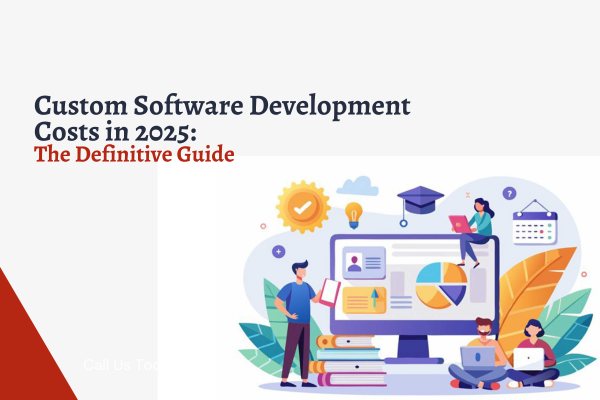
Why Custom Software Development Costs Matter in 2025
From small startups to global enterprises, companies are realizing that ready-made, off-the-shelf software often falls short in meeting their specific needs. That’s where custom software steps in—tailored precisely to the unique workflows, branding, and goals of a business.
In this definitive guide, we’ll break down the real-world cost ranges, factors that influence pricing, regional differences, and proven cost-saving strategies so you can approach your next software project with confidence.
The rising demand for tailored solutions
Businesses in industries from healthcare to retail now rely on unique features—whether that’s HIPAA-compliant patient portals or AI-powered shopping recommendations—that generic software can’t offer. With more businesses moving online, the demand for differentiation is at an all-time high.
For instance, a logistics company might require route optimization integrated with weather forecasting APIs, while a financial institution may need secure, blockchain-based transaction tracking. Both could technically use standard platforms, but they’d risk sacrificing efficiency, compliance, and customer satisfaction.
What is custom software?
Custom software is like a tailor-made suit—it fits perfectly because it’s designed just for you. It aligns with your workflows, integrates seamlessly with your existing systems, and evolves alongside your business.
This category includes:
- Web applications (e.g., a custom CRM for sales teams)
- Mobile apps (e.g., a branded fitness tracker for a gym chain)
- Desktop software (e.g., internal analytics tools for a manufacturing company)
- Embedded systems (e.g., IoT device controllers for smart appliances)
Benefits over off-the-shelf software
Why pay more for custom software when ready-made tools are cheaper and faster to deploy? Here’s why:
- Exact fit for your needs – No unnecessary features that clutter workflows.
- Scalability – Easily expand functionality as your business grows.
- Integration-friendly – Works seamlessly with your existing systems.
- Competitive advantage – Features that set you apart from competitors.
- Ownership & control – No dependency on third-party vendors for updates or licensing.
Key industries leveraging custom solutions in 2025
Custom software demand is booming in:
- Healthcare – Telemedicine platforms, patient data management
- Finance – Secure mobile banking, fraud detection algorithms
- E-commerce – Personalized shopping experiences, supply chain automation
- Manufacturing – IoT-driven production monitoring
- Education – Adaptive learning platforms, virtual classrooms
The Role of Development Models in Pricing
The way you structure your development project has a direct impact on costs. In 2025, the variety of models available means businesses can choose one that aligns with their goals, budget, and flexibility needs.
Fixed-price vs. time-and-materials contracts
A fixed-price contract means you agree on a set budget for the entire project before work begins. This works well for small, well-defined projects with minimal chances of scope changes. However, in software development—where new ideas often emerge mid-project—fixed pricing can become restrictive.
Time-and-materials contracts, on the other hand, are more flexible. You pay for the actual hours worked and resources used. This is ideal for complex or evolving projects where requirements may shift. The risk? Without strong project management, costs can spiral out of control.
Agile vs. waterfall methodologies
- Waterfall follows a strict, linear approach—planning, design, development, testing, and deployment happen in sequence. This can be cheaper upfront but is less adaptable to change.
- Agile focuses on iterative development—breaking the project into sprints where features are built, tested, and reviewed continuously. Agile often leads to higher quality and better alignment with evolving needs, but costs can fluctuate depending on how many sprints are needed.
Outsourcing vs. in-house development
Building an in-house team gives you complete control but requires significant investment in salaries, benefits, and infrastructure. Outsourcing to an external partner or offshore team can reduce costs and speed up delivery—especially if you tap into regions with competitive rates.
Cost Breakdown by Development Stages
Discovery and planning
- Estimated cost: 5–10% of the total budget
- Why it matters: A well-done discovery phase reduces costly changes later.
- 2025 insight: Many companies now use AI-powered requirement gathering tools to speed up and refine this stage.
UI/UX design
- Estimated cost: 10–20% of the budget
- Factors affecting cost: Complexity of animations, number of screens, and accessibility compliance.
- Pro tip: A minimalist, functional design can save costs without sacrificing user satisfaction.
Development and coding
- Estimated cost: 40–60% of the total budget
- 2025 trend: AI-assisted coding tools can reduce development hours by up to 30%, but skilled oversight is still essential.
Testing and quality assurance
- Estimated cost: 10–15% of the total budget
- Approach: Automated testing tools are more common in 2025, but human testers remain critical for catching nuanced issues.
Deployment and maintenance
- Estimated cost: 15–25% annually post-launch
- 2025 reality: Cloud hosting and subscription-based infrastructure services have replaced most on-premise deployment, making costs more predictable but still recurring.
Technologies Powering Mobile App Development in 2025
Mobile app development in 2025 is driven by a blend of cutting-edge frameworks, robust programming languages, and emerging technologies that enable faster development, better performance, and enhanced user experiences. Businesses aiming to create impactful mobile applications should be aware of the tools shaping the industry today.
Cross-Platform Development Frameworks
Cross-platform technologies allow developers to create apps that run seamlessly on both iOS and Android using a single codebase, reducing time and cost. Popular options in 2025 include:
- Flutter – Google’s UI toolkit that offers near-native performance and a rich widget library.
- React Native – Backed by Meta, widely used for scalable, high-performance mobile apps.
- Xamarin – A Microsoft product integrating well with .NET for enterprise solutions.
Native App Development Technologies
For apps requiring maximum performance, device-specific features, and security, native development remains the gold standard:
- Swift – The go-to language for iOS development, optimized for speed and safety.
- Kotlin – The preferred language for Android, offering concise syntax and full Java interoperability.
Backend and Cloud Services
Modern mobile apps rely heavily on cloud-based infrastructure for scalability and real-time functionality:
- Firebase – Google’s backend-as-a-service with authentication, analytics, and push notifications.
- AWS Amplify – A scalable cloud backend for mobile and web apps.
- Supabase – Open-source alternative to Firebase, gaining traction for flexibility.
Emerging Technologies Enhancing Mobile Apps
In 2025, mobile apps are more intelligent and immersive than ever, thanks to:
- AI & Machine Learning – Personalization, predictive analytics, and intelligent chatbots.
- AR/VR – Augmented and virtual reality for gaming, education, and retail experiences.
- IoT Integration – Mobile apps connecting seamlessly with wearables, smart home devices, and industrial sensors.
- 5G Connectivity – Enabling faster data transfer, high-quality streaming, and real-time features without lag.
Impact of AI and Automation on Development Costs in 2025
Artificial intelligence and automation are rewriting the playbook for software development in 2025. While these technologies can streamline workflows and reduce manual labor, they also introduce new costs in the form of specialized skills, advanced infrastructure, and ongoing AI model training.
AI-assisted coding tools
Platforms like GitHub Copilot, Tabnine, and other AI-based code generation tools have made it possible to write functional code faster than ever. This reduces development time for routine tasks—such as generating boilerplate code, creating database schemas, or writing unit tests—cutting costs in these areas.
Automated testing
Automation in QA is one of the most effective cost savers. AI-driven testing tools can run thousands of test cases in minutes, catching bugs early and reducing the hours spent on repetitive manual checks.
Predictive analytics for project planning
One of the most exciting 2025 trends is using AI for predictive project management. By analyzing historical data from past projects, AI can forecast risks, estimate timelines, and suggest resource allocation strategies to prevent cost overruns.
Real-World Case Studies from 2025
A fintech startup success story
A fintech company in New York wanted to launch a peer-to-peer payment app with advanced fraud detection. They opted for an MVP first, focusing only on essential features like account creation, secure transfers, and transaction history.
Cost: $95,000 (MVP)
Result: Within six months, the app gained 50,000 users. Revenue from transaction fees funded the second development phase, which added AI-powered fraud detection and cryptocurrency support.
Scaling enterprise applications
A global manufacturing firm built a custom IoT-powered production monitoring system. Instead of going full-scale immediately, they deployed the system at two plants first.
Cost (Phase 1): $450,000
Savings: Avoided $120,000 in potential downtime by identifying early integration issues before company-wide rollout.
Lessons from failed projects
A mid-sized e-commerce retailer attempted to build a fully customized online store with every possible feature from day one—multi-language, AI recommendations, live chat, VR shopping, and more.
Cost: $320,000
Outcome: Over budget and late by 8 months. By launch, many features were outdated or unused. This illustrates why prioritizing MVPs is critical to avoiding waste.
Read More: Guide to D2C E-Commerce Platform Development in 2025: A PTI WebTech Perspective
Choosing the Right Development Partner
Selecting the wrong development partner can inflate your costs and derail your timeline. In 2025, with remote and global teams being the norm, due diligence is more important than ever.
Vetting portfolios and references
Don’t just rely on polished websites—ask for case studies, speak with past clients, and look for evidence of successful projects in your industry.
Communication and transparency
Your development partner should have clear reporting systems, regular check-ins, and transparent pricing models. Poor communication often leads to scope creep—one of the most common causes of cost overruns.
Contracts and intellectual property rights
Ensure your contract specifies that you own the code and intellectual property once the project is complete. Also, clarify terms for post-launch support, bug fixes, and updates.
The Future of Custom Software Development Pricing
Looking ahead to 2026 and beyond, several trends are likely to shape costs:
- Increased AI integration in both development and product features
- Greater demand for cybersecurity features due to rising digital threats
- More specialized developer roles, driving up costs for niche skills
- Sustainable development practices, which may add initial cost but lower long-term expenses
The Final Thought
At PTI WebTech, we believe that custom software development ,our team combines technical expertise with a deep understanding of business processes, ensures every product we deliver is tailored to specific goals, scalable for future needs, and robust enough to stand the test of time.
Whether it’s creating enterprise-grade platforms, intuitive mobile applications, or complex e-commerce solutions, our focus remains the same: delivering high-quality, cost-effective, and future-ready software that empowers organizations to thrive in an ever-changing digital world. With a proven track record, global clientele, and a commitment to transparent collaboration, PTI WebTech stands as a trusted partner for businesses ready to turn their vision into reality.


